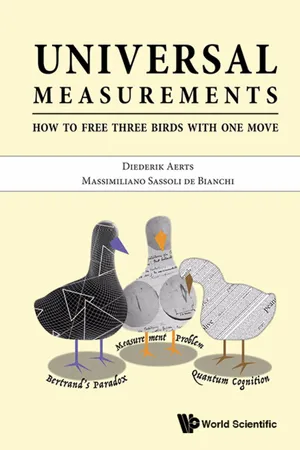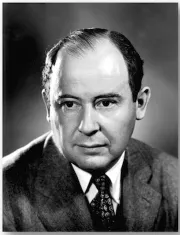![]()
Chapter 1
Bertrand’s Paradox
As indicated in the title, and in the preface, the central theme of this booklet is the notion of universal measurement (or universal average). Our goal is to explain how this fundamental notion can solve three major problems, in three fields of knowledge: the measurement problem (or the problem of observation) in quantum theory, the Bertrand’s paradox in probability theory, and the problem of the unreasonable effectiveness of quantum probabilities in experimental psychology. We will start by addressing the famous Bertrand’s paradox, which since 1889 has been a threat to the validity of the so-called principle of indifference, on which the entire probability calculus is based. Joseph Louis François Bertrand (1822–1900) was a famous French mathematician (see Figure 1.1), who contributed to many fields of human knowledge: number theory, differential geometry, probability theory, economics and thermodynamics. In his celebrated book on probability theory (Bertrand, 1889), he enunciated the following problem:
If we draw at random a chord onto a circle, what is the probability that it is longer than the side of the inscribed equilateral triangle?
Bertrand gave three different answers to his seemingly innocent question, associated with three distinct values for the probabilities in question. And because these three answers each appears to be based on a perfectly correct and logical reasoning, Bertrand’s problem was subsequently qualified as a paradox (by Henri Poincaré).
Fig. 1.1 J. L. F. Bertrand.
The first solution proposed by Bertrand consists in choosing an arbitrary point on the circle, considering it as one of the vertexes of an inscribed equilateral triangle. This point, which describes one of the two intersection points of the chord with the circle, is kept fixed, while the second varies (so that the chord can move as a kind of pendulum). If we consider all possible points on the circle (relative to this second intersection point), we can see that the chord will rotate by a total angle of 180°, but that only those chords that intersect the arc subtended by an angle of 60° at the vertex (see Figure 1.2) will meet the requirement of being longer than the side of the inscribed equilateral triangle. Therefore, the probability P sought is given by the ratio:
The second solution proposed by the French mathematician consists in first choosing an arbitrary direction and then considering all the chords that are parallel to that direction. Then, moving the chords along the circle, one observes that those intersecting its diameter (perpendicular to them) in its central segment, whose length is half the diameter of the circle (see Figure 1.3), satisfy the condition of being longer than the side of the inscribed equilateral triangle. This time, the probability is therefore given by the ratio:
Fig. 1.2 A graphical representation of Bertrand’s first solution.
Fig. 1.3 A graphical representation of Bertrand’s second solution.
Finally, the third solution proposed by Bertrand consists in choosing an arbitrary point inside the circle and consider it as the middle point of the chord. If we move this point around the entire area of the circle, we can observe that all the chords having their middle point within an internal smaller circle whose radius is one half the radius of the big circle (see Figure 1.4), and which is the incircle of the equilateral triangle, satisfy the condition of being longer than the side of the inscribed equilateral triangle. The area of the internal circle being one fourth of the area of the big circle, this time, the probability is given by the ratio:
Fig. 1.4 A graphical representation of Bertrand’s third solution.
In summary, proceeding with the above three arguments, all apparently valid, one gets three different values for the desired probability:
and
.
What is the current status of Bertrand’s paradox? Well, according to a recent analysis by philosopher Nicholas Shackel (Shackel, 2007), the situation is that after more than a century the paradox remains unsolved and continues to stand in refutation of the so-called principle of indifference, according to which: alternative events for which there are equal reasons are equally likely to occur.1
Even more recently, and more pessimistically, philosopher Darrell P. Rowbottom affirmed that Bertrand’s proposed solutions to his question, which generate his chord paradox, are all inapplicable, so that there is no solace for the defenders of the principle of indifference, as it emerges that the paradox is much harder to solve than previously anticipated (Rowbottom, 2013).
This was the situation when we “stumbled” on what we believe is a compelling solution to the problem, which allows saving the validity of the principle of indifference. If we say that we “stumbled” on the solution it is because, while working on another famous theoretical problem namely the measurement problem in quantum mechanics, we realized that Bertrand’s paradox was precisely one of the obstacles that stood between us and the solution to the problem. So by looking for a solution to the latter, we have also obtained, as a bonus, a solution to the former.
This intimate connection between the foundations of probability theory and the foundations of quantum theory, however, should not be a surprise. Indeed, it is not the result of a coincidence, since both these approaches to reality aim to describe systems that are subjected to specific actions, according to protocols that incorporate the presence of irreducible fluctuations, so much so that the results of these actions cannot be predicted with certainty, not even in principle (from which the necessary use of probabilities follows). In this sense, we could say that the founding fathers of probability theory, without knowing it, were actually quantum physicists ante litteram, as we will explain in more detail later in the text. We can also observe that the precise axiomatic formalization of probability theory, achieved by one of the most important and influential mathematicians of the twentieth century, the Russian Andrey Nikolaevich Kolmogorov (see Figure 1.5), took place exactly in the same years when the precise axiomatic formalization of quantum theory was obtained by the Hungarian mathematician and physicist John von Neumann (see Figure 1.6). In fact, while Kolmogorov’s founding text is dated 1933 (Kolmogorov, 1933), von Neumann’s was published just a year before (von Neumann, 1932). This is to say that modern probability theory has developed in parallel with quantum theory, which in part also explains the difficulty, to quantum physicists, of understanding the true nature of the quantum probabilities, which are said to be non-Kolmogorovian precisely because they violate the famous classical axioms enunciated by Kolmogorov.
Fig. 1.5 A. N. Kolmogorov.
Fig. 1.6 J. von Neumann.
But let us go back to Bertrand’s paradox. For didactical reasons, we will proceed contrariwise to the path that we have followed in our research, that is, we will use the solution of Bertrand’s paradox to explain how it is possible to obtain a solution to the measurement problem.
The first thing we need to observe is that Bertrand’s question actually hides two separate problems: an easy one and a hard one. These two problems must be carefully separated if one wants to get an unambiguous answer to his question.
The first problem, the easy one, is just about defining in a precise way the entity that is subjected to the statistical study, in our case the chord to be randomly drawn onto the circle. According to Bertrand, the chord in question is simply a straight line, that is, an abstract entity that is the mathematical modelization and idealization of different possible material entities. In fact, in practical terms, one can draw a line by throwing a sufficiently long straw onto a circle drawn on the floor, but also by tossing two pebbles, to be used then as the points to draw the straight line. But tossing a straw, or two pebbles, are two very different physical processes, which are not going to produce the same statistical distribution of straight-line segments.
Now, if we look closely at the logical construction of Bertrand’s first solution, we can see that it describes a process where the line is constructed from two randomly chosen points. So, in its first solution, the French mathematician had in mind a physical process of the “tossing of two pebbles” kind. Instead, the second solution is undoubtedly a process of the “tossing of a straw” kind, even though it is a rather unusual tossing, since the orientation of the chord and its displacement towards the circle are determined in a sequential way by the thrower. Finally, its third solution is a mixed process, where a pebble is first tossed, to define the midpoint of the chord, and then a straw is tossed, to define its orientation.
While this ambiguity is maintained in Bertrand’s statement, i.e., while in the question several non-equivalent questions remain mixed, referring to different physical entities (two pebbles, a straw, or a pebble and a straw), we will be dealing with an artificially created paradox, that is, a false paradox. In other words, to address Bertrand’s paradox, the first thing to do is to make his question operationally precise, by specifying the nature of the material entity of which the chord is the abstract modelization.
For example, let us suppose that the entity is a straw (or rather, the idealization of a straw, that is, a very long, thin and stiff object). Would this allow us to determine that only Bertrand’s f...











